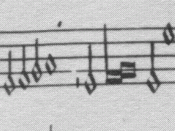Music has always been evolving. Usually the changes are slow and gradual, but in certain points throughout history, great strides and innovations are made, causing an unmistakable shift in the way people play, write, and think about music. One of the most important shifts occurred between the Medieval and Renaissance time periods. The Medieval period is usually considered to be between 476 and 1450, and the Renaissance period is considered to be from 1450 to 1600. 1450 marked the turning point. This point showed great advancements in the way of music theory, specifically, through the understanding and usage of polyphony, rhythm, harmony, as well as many other elements of music.
For a brief period, there was an overlap in the polyphonic styles. At the start of the early 16th century, the old polyphonic style was being taken over by the new one. There is a collection of works which was compiled in the early 16th century in a Franciscan monastery in Belgium.
It consisted of 75 paper folios, and within them, two different styles of notation were utilized. The old square notation is used on a few of them, but the white mensural notation, used almost entirely in note-against-note style, dominates the older style. Within the same folio, there are also two versions of the same chant, the older version which was written for three voices, and the newer one which was written for four. While the cantis firmi are still in the tenor, that voice is now the second from the bottom, and for this time period, it started to be widely used in intervals of thirds with the lowest voice. This was a much different way of looking at the structure of different voices.
The polyphonic music during the medieval period grew from the relatively simple harmonies of...


